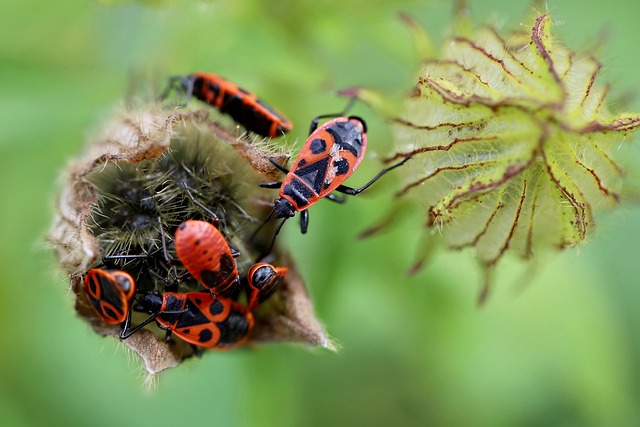Boxelder bugs (Boisea trivialis) are year-round pests in North America, active in egg, nymph, and adult stages. They primarily live in boxelder trees but infest homes during colder months, drawn by light and warmth. Non-chemical methods like vacuuming, sealing entry points, and using sticky traps provide eco-friendly extermination, while chemical treatments with insecticides offer a powerful solution for severe infestations. Preventative measures include caulking gaps, regular cleaning, and maintaining a tidy lawn. Professional pest control services offer specialized treatments for existing infestations, minimizing environmental impact and ensuring effective resolution.
Tired of finding boxelder bugs invading your walls and windows? This comprehensive guide is your solution. We’ll walk you through understanding these pesky critters, their behavior, and preferred habitats. Explore non-chemical methods for a safer removal process, or opt for chemical treatments for swift extermination. Learn essential prevention techniques to keep them at bay in the future. Discover expert tips tailored for effective boxelder bug extermination.
Understanding Boxelder Bugs: Behavior and Habitat
Boxelder bugs, scientifically known as Boisea trivialis, are a common household pest found in many parts of North America. Understanding their behavior and habitat is crucial for effective boxelder bug extermination. These insects primarily live on boxelder trees, but they also infest homes during the colder months when they seek warmth and shelter. They are attracted to light and can often be seen clustering around windows and walls, especially at night.
Boxelder bugs have a lifespan of about one year, with three distinct stages: egg, nymph, and adult. The eggs are typically laid in the spring on tree branches or inside cracks and crevices of buildings. Nymphs hatch and begin feeding on plant sap, before undergoing a series of molts to reach adulthood. Adult boxelder bugs mate during the summer and fall, after which they search for protective places to spend the winter months. This seasonal migration makes them more prominent indoors during late autumn and winter.
Non-Chemical Methods for Boxelder Bug Removal
Non-Chemical methods offer a more environmentally friendly approach to boxelder bug extermination, ideal for those seeking to avoid harsh chemicals. One effective technique involves using a vacuum cleaner with a brush attachment to carefully suck up the bugs from walls and windowsills. This method is particularly useful for early detection and prevention, as it removes the insects before they have a chance to lay eggs or establish a colony.
Another natural solution is to employ physical barriers like caulk or weather stripping around windows and doors. Sealing entry points helps prevent boxelder bugs from returning after removal. Additionally, insect lights or sticky traps can be used as a monitoring tool, attracting and capturing any remaining boxelder bugs, ensuring a more comprehensive extermination process.
Chemical Treatments for Effective Extermination
Chemical treatments offer a more aggressive approach to boxelder bug extermination, particularly for severe infestations. While this method should be considered as a last resort due to potential health and environmental risks, it can be highly effective in eliminating large populations of these insects from walls and windows.
The most common chemicals used for boxelder bug extermination include insecticides containing pyrethroids or neonicotinoids. These synthetic compounds mimic natural substances found in plants that disrupt the nervous systems of insects. Professional pest control services typically apply these treatments directly to infested areas, ensuring minimal impact on non-target organisms and nearby environments.
Preventing Future Infestations
To prevent future infestations of boxelder bugs, it’s crucial to take proactive measures around your home, especially during times when these insects are most active, like late summer and early fall. One effective strategy is to seal any gaps or cracks in walls, windowsills, and doors using caulk or weatherstripping. This helps keep the bugs from finding their way inside. Regularly cleaning and vacuuming, particularly focusing on corners and crevices, can also remove eggs and nymphs before they mature. Additionally, maintaining a tidy lawn and removing fallen trees or branches nearby can reduce habitat for boxelder bugs, as these structures provide ideal shelter and nesting sites.
For those considering boxelder bug extermination, it’s important to understand that prevention is often the most effective and least disruptive approach. Professional pest control services offer specialized treatments tailored to address existing infestations and stop them from recurring. These methods may include insecticides applied to specific areas or whole-home treatments, ensuring a thorough and safe resolution. By combining these preventative measures with professional assistance when needed, homeowners can significantly reduce the likelihood of future boxelder bug invasions.
When dealing with boxelder bugs, a comprehensive approach is key. Understanding their behavior and habitat allows for effective non-chemical methods like vacuum cleaning and sealing entry points. For severe infestations, chemical treatments offer a swift solution. Preventative measures such as regular inspections and proper storage of seasonal items are essential to avoid future boxelder bug extermination challenges. By combining these strategies, you can safely and successfully rid your walls and windows of these pests while minimizing the need for chemical interventions.
